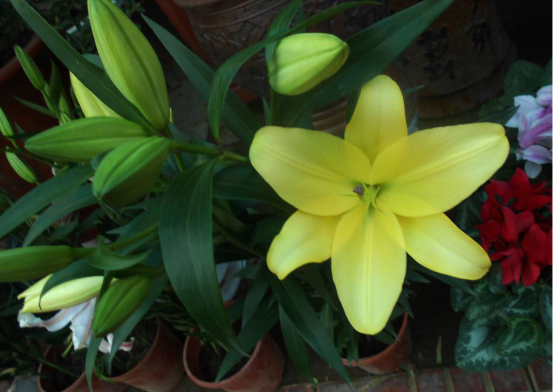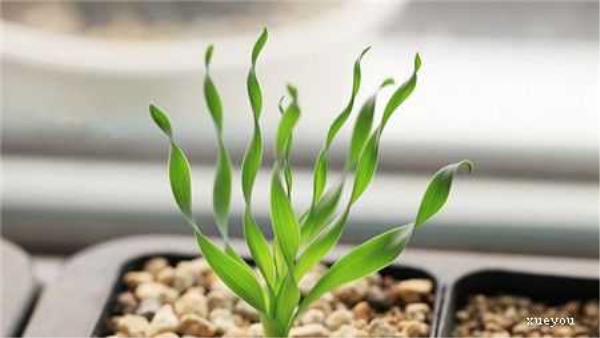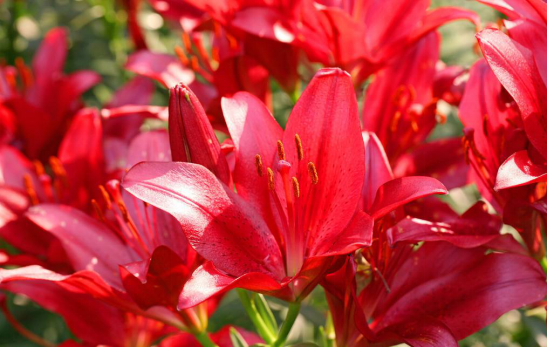Culture of lilies
Environment
Soil: cultivated lily is suitable for sandy soil with good drainage and rich humus content, and it is best to choose acidic soil, which is conducive to its better growth.
Temperature: the best temperature for breeding lilies is 16-24 ℃. If the temperature is less than 5 ℃ or higher than 30 ℃, the lilies will stop growing.
Lighting: lilies like plenty of sunlight, short time will affect the differentiation of flower buds, but also affect the normal growth of flowers, so it is best to put it in a sunny place.
Watering: to maintain the moisture of the lily soil, you can water the soil in the morning and evening in summer and autumn. Before watering in spring and winter, you should look at the wettability of the soil. If the soil is dry, water should be properly watered. Spray water around when the temperature is high to reduce the temperature.

Common diseases
Spot disease: there will be brown spots on the leaves, and in serious cases, it will blacken the whole leaf and wither the plant. When found, the diseased leaves should be removed immediately and sprayed with Dyson zinc wettable powder.
Bulb rot: a brown spot appears in the bulb of the lily, which will rot when it is serious. After the disease, it can be sprayed with Dysen zinc.
Now that we know how to raise lilies, how can we make them bloom more and more? Let's take a look at the breeding methods of lilies.
How to raise lilies and the culture methods of lilies
Lily means a hundred years of love. For Chinese people who talk about the jackpot, lilies are also common at wedding banquets. Many lilies will begin to raise lilies in spring, but lilies are not easy to feed. Today, I would like to share with you how to raise lilies and how to cultivate lilies.
Lilium is a perennial herb of Liliaceae, which is native to China, Japan, Korea and so on. It likes moist and light, and requires sandy soil that is fertile, rich in humus, deep soil layer and good drainage. Most varieties should grow in slightly acidic to neutral soil.
Culture methods of lilies
Planting: the north should choose the sun shelter, the south can be planted in a slightly shaded place. The suitable planting time is from August to September. Apply enough base fertilizer one month before planting and turn the soil deeply. Compost and plant ash can be used as base fertilizer. The general depth of planting is 3-4 times the diameter of the bulb to facilitate the rhizome to absorb nutrients. If planted too shallowly in the north, it is vulnerable to freezing damage in winter, and will affect the growth of roots and bulbs. Weeding during the growth period should not be ploughed in order to avoid damage to the rhizome. If possible, you can sprinkle some sawdust on the planting ground to cover the soil. In this way, it can not only prevent the growth of weeds, but also preserve soil moisture and reduce soil moisture to facilitate the development of bulbs.
Potted plants should be carried out from September to October. The cultivated soil should be mixed with rotten leaf soil, sandy soil and garden soil at the ratio of 1:1:1, and the basin bottom should be fully mature compost and a small amount of bone powder as base fertilizer. The planting depth is generally about 2-3 times the diameter of the bulb. Lily does not have a high demand for fertilizer, which is usually applied at the beginning of spring growth and the early stage of flowering. Lilies need more nitrogen and potash fertilizer. Potash fertilizer should be applied every 10-15 days during the growing period, while the supply of phosphorus fertilizer should be limited, because too much phosphorus fertilizer will cause withered and yellow leaves. Phosphate fertilizer can be increased by 1-2 days at flowering stage. In order to enrich the bulb, the residual flowers should be cut off in time after flowering to reduce nutrient consumption. Watering only needs to keep the pot soil moist, but it should be watered properly during the peak growing season and dry weather, and often sprinkle water around the flowerpot to improve air humidity. Pot soil should not be too wet, otherwise bulbs are easy to rot, potted lilies change pots once a year and replace them with new culture soil and base fertilizer. In addition, the flowerpot should be turned once a week during the growing period. Otherwise, the plant is easy to be too long, affecting the appearance.
Loading
How to cultivate lilies the culture methods and matters needing attention of lilies
Lilies not only grow beautiful but also very fragrant, very popular with people, how to grow lilies? Next, let's talk about the breeding methods and points for attention of lilies.
Culture methods of lilies:
1. Soil: the pot culture soil of lily should be mixed with rotten leaf soil, sand soil and garden soil at the ratio of 1:1:1, and the pot bottom should be fully mature compost and a small amount of bone powder as base fertilizer.
2, sunshine: lilies like light, if the lack of sunlight, long-term shade will affect the normal flowering. In addition, the flowerpot should be turned once a week during the growing period. Otherwise, the plant is easy to be too long, affecting the appearance.
3. Temperature: the temperature of lily growth and flowering is 16024 ℃, below 5 ℃ or above 30 ℃ almost stops, the plant grows normally above 10 ℃, and stagnates when it exceeds 25 ℃. If the night temperature in winter is lower than 5 ℃ and lasts for 5 to 7 days, flower bud differentiation and bud development will be seriously affected, postpone flowering or even blind flower and flower crack.
4. Watering: watering only needs to keep the pot soil moist, but the growing season and dry weather should be properly watered frequently, and often sprinkle water around the flowerpot to improve air humidity. The potted soil should not be too wet, otherwise the bulbs will rot easily.
5. Fertilization: lilies do not have high requirements for fertilizer, usually at the beginning of spring growth and the early stage of flowering. Some foreign growers believe that lilies need more nitrogen and potassium fertilizer, and should be applied every 10 to 15 days during the growing period, while the supply of phosphate fertilizer should be limited, because too much phosphate fertilizer will cause withered and yellow leaves. Phosphate fertilizer can be increased by 1 to 2 days at flowering stage.
6. Insect pests: the common diseases of lilies are lily mosaic disease, bulb rot, spot disease, leaf blight and so on. When the spot disease occurs, the diseased leaves can be removed and sprayed once with 65% Dysen zinc wettable powder 500 times dilution to prevent spread.
7. Pruning: in order to enrich the bulb, the residual flowers should be cut off in time after flowering, so as to reduce nutrient consumption and affect the blooming of other flowers.
Points for attention in lily culture:
Pot planting should be carried out from September to October. The cultivated soil should be mixed with rotten leaf soil, sandy soil and garden soil at the ratio of 1:1:1, and the basin bottom should be fully mature compost and a small amount of bone powder as base fertilizer.
The planting depth is generally about 2-3 times the diameter of the bulb. Lily does not have a high demand for fertilizer, which is usually applied at the beginning of spring growth and the early stage of flowering. Some foreign growers believe that lilies need more nitrogen and potassium fertilizer, and should be applied every 10 to 15 days during the growing period, while the supply of phosphate fertilizer should be limited, because too much phosphate fertilizer will cause withered and yellow leaves.
Phosphate fertilizer can be increased by 1 to 2 days at flowering stage. In order to enrich the bulb, the residual flowers should be cut off in time after flowering to reduce nutrient consumption. Watering only needs to keep the pot soil moist, but it should be watered properly during the peak growing season and dry weather, and often sprinkle water around the flowerpot to improve air humidity.
Pot soil should not be too wet, otherwise bulbs are easy to rot, potted lilies change pots once a year and replace them with new culture soil and base fertilizer. In addition, the flowerpot should be turned once a week during the growing period. Otherwise, the plant is easy to be too long, affecting the appearance.
- Prev

Matters needing attention in culturing spring grass
There is a great demand for nutrients during the growth period of spring grass, so we need to apply mature dilute liquid fertilizer once a month to promote plant growth. When blooming in spring, you can spray some phosphate fertilizer to promote flowering. The above is the introduction of the breeding methods and matters needing attention of spring grass.
- Next

Propagation methods of lilies
Sowing and propagation collect lily seeds in advance and store them, and sow them in the next spring. About a month after sowing, lilies will sprout. They should be shaded in their seedling period, and can be planted separately in autumn. After cutting propagation, the bulbs are dug out and the scales are broken off.
Related
- Fuxing push coffee new agricultural production and marketing class: lack of small-scale processing plants
- Jujube rice field leisure farm deep ploughing Yilan for five years to create a space for organic food and play
- Nongyu Farm-A trial of organic papaya for brave women with advanced technology
- Four points for attention in the prevention and control of diseases and insect pests of edible fungi
- How to add nutrient solution to Edible Fungi
- Is there any good way to control edible fungus mites?
- Open Inoculation Technology of Edible Fungi
- Is there any clever way to use fertilizer for edible fungus in winter?
- What agents are used to kill the pathogens of edible fungi in the mushroom shed?
- Rapid drying of Edible Fungi

